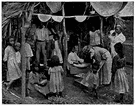Car·ib
(kăr′ĭb)n. pl. Carib or Car·ibs
1. also Car·i·ban (kăr′ə-bən, kə-rē′bən) A member of a group of American Indian peoples of northern South America, the Lesser Antilles, and the eastern coast of Central America.
2. Any of the languages of the Carib.
[Spanish Caribe, from earlier Carib karibna, person, Carib.]
Car′ib adj.
American Heritage® Dictionary of the English Language, Fifth Edition. Copyright © 2016 by Houghton Mifflin Harcourt Publishing Company. Published by Houghton Mifflin Harcourt Publishing Company. All rights reserved.
Carib
(ˈkærɪb)npl -ibs or -ib
1. (Peoples) a member of a group of American Indian peoples of NE South America and the Lesser Antilles
2. (Languages) the family of languages spoken by these peoples
[C16: from Spanish Caribe, from Arawak]
ˈCariban adj
Collins English Dictionary – Complete and Unabridged, 12th Edition 2014 © HarperCollins Publishers 1991, 1994, 1998, 2000, 2003, 2006, 2007, 2009, 2011, 2014
Car•ib
(ˈkær ɪb)n., pl. -ibs, (esp. collectively) -ib for 1.
1. a member of an American Indian people that aboriginally inhabited parts of the Lesser Antilles and the South American coast from E Venezuela to the Amazon delta.
2. the Cariban language of these people.
3. Cariban.
[1545–55; < Sp caribe < Arawak]
Random House Kernerman Webster's College Dictionary, © 2010 K Dictionaries Ltd. Copyright 2005, 1997, 1991 by Random House, Inc. All rights reserved.
ThesaurusAntonymsRelated WordsSynonymsLegend:
| Noun | 1. |  Carib - a member of an American Indian peoples of northeastern South America and the Lesser Antilles Carib - a member of an American Indian peoples of northeastern South America and the Lesser AntillesAmerindian, Native American - any member of the peoples living in North or South America before the Europeans arrived |
| 2. | Carib - the family of languages spoken by the Carib American-Indian language, Amerind, Amerindian language, American Indian, Indian - any of the languages spoken by Amerindians |
Based on WordNet 3.0, Farlex clipart collection. © 2003-2012 Princeton University, Farlex Inc.